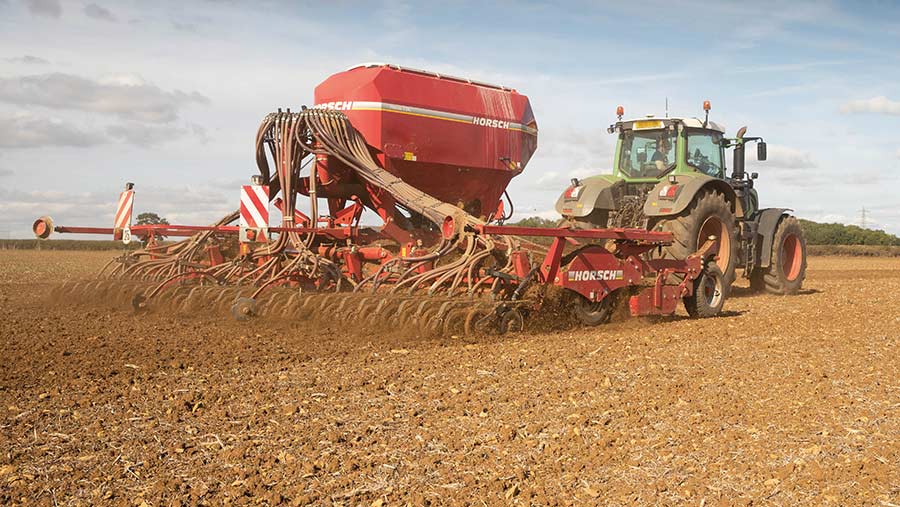Cost of farm inputs soars 34% in a year
 © Tim Scrivener
© Tim Scrivener Farm input inflation has reached unprecedented levels, with seven out of nine categories seeing double-digit cost increases in the past year, threatening the viability of many farm businesses.
Latest figures from the country’s largest buying group, AF, show that, in the 12 months to September 2022, the cost of farm inputs went up by an “eye-watering” 34%.
Animal feed and medicine, fuel and power, and fertilisers saw the greatest increases at 36%, 43% and 134%, respectively, while machinery (including depreciation) climbed 25%.
See also: 10 ways one farm makes suckler beef profitable
Some input categories, however, have been less prone to inflationary pressures – for example, labour costs and crop protection products, which climbed 6% and 13%, respectively.
As for the different farming sectors, cereals and oilseed rape production have been the hardest hit, with input cost increases of just over 40%. Potato production has also suffered input rises of just under 40%, followed by dairying (37%), beef and lamb (35%) and sugar beet (30%).
AF chief executive David Horton-Fawkes described the results as “alarming”. “The spiraling costs of farm inputs exceeds anything we have seen since we first published our index in 2006,” he said.
“These findings are an existential threat to many farmers and we are seeing signs that some businesses are beginning to struggle.”
One symptom was an increase in the number of people looking to extend their credit deadlines. “That’s difficult because, as a co-op, we have to treat everyone the same, but we are having more of those calls,” said Mr Horton-Fawkes.
Some distributors were at least offering deferred payments, he added, and farmers were keen to take advantage.
Consumer spending
As well as the rises in farmer input costs, AF also tracks how much consumers are spending on related food categories, to see if they are keeping up.
Latest figures from the Office for National Statistics show that general inflation, as measured by the Consumer Price Index, is now running at more than 10% – the highest it has been for 40 years – with food and non-alcoholic beverages leading the way at 14.3%.
But only in the dairy sector are retail milk price rises ahead of farm input inflation, having seen a 44% increase in the past 12 months. This in part explains why farmgate prices for dairy farmers have risen.
Overall, however, the gap between the increased costs to consumers and the actual costs of food production is widening, with serious shortfalls for beef and lamb (18%), granulated sugar, bread and margarine (all about 20%) and, worst of all, potatoes (29%).
Farm margins
For farmers, it is farmgate prices that also determine margins and, according to Sanjay Dhanda, senior economist at the NFU, arable and dairy farmers have enjoyed some level of protection as output prices have also been quite firm.
“However, our research shows that in other sectors – particularly poultry, which has been hit by avian influenza as well as rising costs – output prices have not caught up,” he said.
“And it is not only cost increases that are affecting farmers, it is the uncertainty.
“Yes, some inputs have come down in price recently. Gas, for example, has been helped by the mild autumn lowering demand and enabling some stockpiling to take place. But this might be creating a false sense of security and, given the geopolitical situation, prices could change very quickly.”
‘Be prepared’
In preparation, Mr Horton-Fawkes urged farmers to plan their cashflows carefully, and to use AF’s Aginflation Index to work with processors and advisers to “confront these brutal facts”.
With sterling looking weaker, there are fears that imported inputs – especially crop protection products, which so far have seen relatively muted price increases – may go up again.
There are some encouraging signs, however. “We were concerned that some arable farmers who’d bought their inputs early were going to have a bonanza this year and would not prepare for next year,” said Mr Horton-Fawkes. “My sense is that people are now planning ahead.”
Budgeting book highlights pressure on margins
The effect of rising input costs on farm margins is spelled out in the latest Farm Management Handbook 2022-23 from SAC Consulting, which is available free online.
It highlights how Russia’s invasion of Ukraine has led to a tripling of fertiliser prices, and how higher energy and fuel costs are also taking their toll on farm businesses. But while input costs have risen, the value of outputs has also increased for grain, milk, beef and sheep.
“Despite this, gross margins for beef enterprises have reduced across the board, because the increase to variable costs has more than outstripped the increased beef price,” it says. “Gross margins for sheep and arable enterprises show mixed results, depending on the system or crops being grown.
“It is only in the dairy industry that gross margins have improved during the past year, with increases to farmgate milk price more than covering the variable cost increases.”
However, gross margins only account for “output less variable costs”, such as vet and medicine bills, feeds, fertiliser, silage, seed and sprays.
“Fixed costs such as power and machinery, labour, rent and finance are not included in these figures and, therefore, improved gross margins are not necessarily an indicator of improved overall profitability,” said SAC Consulting.
